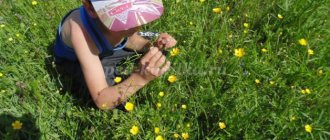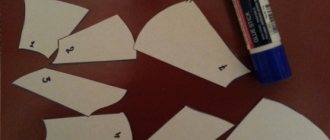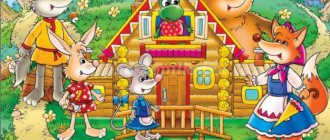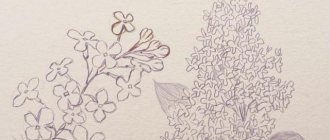MAGAZINE Preschooler.RF
Collection of notes from winter walksAuthor: Marina Aleksandrovna Chistyak, teacher, highest qualification category of MKOU for orphans and children left without parental care, “Family”
Abstract No. 1.
Topic: “Winter is cold”
Goal: to form in children the first coherent ideas about this time of year.
Walking progress:
Organizing time.
While getting ready for a walk, the teacher tells the children: “Pay attention to your clothes. We all dress warmly, because it is very cold, frosty, winter outside.
Observation.
During a walk, the teacher draws the children’s attention to the clothes of passers-by: “See? Grandfather walks in felt boots and a fur hat. He dressed warmly so that the frost would not chill him. Here it is, winter-winter, fierce cold! But the boy runs, jumps up so that it doesn’t feel cold. The birds hid from the cold. No one is visible, the cold winter has driven everyone away. Only one wind blows. Listen to him sing: “V-V-V! V-v-v!” Repeat how the angry winter wind sings and howls .
The teacher asks to check how much snow there is today. Children take shovels, pick up snow, and throw it. The snow scatters in a light cloud. The teacher clarifies: “Loose . You can’t sculpt - they all decide and agree to make a snow slide.
Work. Everyone approaches the snow bank and decides where it is best to build a slide: far or close to the veranda, above or below the snow bank - and they begin to “work” .
The teacher cuts out a slide from the snow (height 40-60 cm). Children help: clean up the edges, shovel snow, trim the slope.
As soon as the construction is completed, everyone takes the equipment to the site, collecting buckets, shovels, and shaking them off the snow.
Independent activity of children.
The kids begin to roll their dolls down the slide. The elders decorate its edges with colored pieces of ice (patterns, flowers) together with the adult.
Outdoor game "Santa Claus" .
Abstract No. 2.
Topic: "Snowfall" .
Goal: to introduce children to a seasonal phenomenon - snowfall.
Walking progress:
Organizing time.
While getting ready for a walk, the teacher tells the children: “Pay attention to your clothes. We all dress warmly, because it is very cold, frosty, winter outside.
Observation.
The children go for a walk and see that it is snowing. "Snow! It is snowing!" - they tell the teacher. "Right! - says the teacher. - Snowing. There was a lot of snow all around. Look, there is already snow on the path, on the bench, and on the table. And he keeps falling and falling. It's snowing!" Children repeat: “Snowfall!”
The teacher continues: “Snowflakes are slowly spinning in the air. They spin around and sit down, in all directions. Do they sit on us?” The children carefully examine themselves: “And she sat on my felt boots!” And on my mitten!”
“Look like a star!” - says the teacher and offers to look at the beautiful snowflake that fell on the sleeve. The teacher suggests putting your hand towards the falling snow, and when a large snowflake falls on the mitten, blow on it. “Flying? Let it fly further! The snowflake is light, fluffy, beautiful!”
Then he takes off the mitten and invites the children to watch what happens to the snowflake. Explains: “A snowflake sat on my hand and melted. It was, and now it’s no longer there! What a little star .
Having prepared the children’s perception for the bright characteristics of a snowflake (a star, a little one, melted in the palm of the hand), the adult reads the poem by 3. Christmas “Little Star” , repeating its ending twice:
She sat down and melted on my palm.
Children repeat: “The snowflake is light, fluffy, beautiful, like a star . “What color is she? - asks the teacher. - Who has a fur coat the same white color? This means we also have fluffy snowflakes! Blow on them. Let our white fluffy snowflakes fly!”
After this, the adult says: “What a snowfall! A lot of snow fell, everything was covered all around. The winter-winter is trying, wrapping the bushes in snow, putting a hat on the Christmas tree. Look what color the winter-winter is?” Children say: winter is white.
Outdoor game.
After finishing the observation, the children play the outdoor game “Snow is spinning” .
Work. After some time, the teacher invites those who wish to clear the area in front of the veranda from freshly fallen snow. Children choose their own shovels or sliders and, together with adults, remove the snow: some move the snow towards the snow bank, others throw it up (the teacher shows the actions). Then, if desired, you can sweep the area.
Independent artistic activity of pupils.
Having finished clearing the playground, children and their teacher can decorate it by placing multi-colored flags along the snow bank, placing multi-colored ribbons between them, and laying out patterns of multi-colored ice floes along the slope. The teacher praises them and thanks them for their diligence.
Some children play, others watch the actions of their comrades. The teacher can turn to a subgroup of 3-5 children and, holding out his hand towards the falling snow, ask them to guess: “White, fluffy, fell on his hand and disappeared. What it is? Did you guess right?
The walk continues.
Note No. 3
Topic: “Bird behavior in winter”
Goal: to develop in children a desire to take care of wintering birds; learn to recognize birds and name their body parts.
Walking progress:
Organizing time.
While getting ready for a walk, the teacher tells the children: “Pay attention to your clothes. We all dress warmly, because it is very cold, frosty, winter outside.
Observation.
Children go for a walk. The teacher draws their attention to the wintering birds and tells them that in winter they are hungry: there are no midges, no worms, only people can help - feed them.
Children repeat after adults: “Hello, little birds! Have you come to visit us? Now we will treat you!” The teacher invites them to watch how the birds will treat themselves, explains: they need to scatter the food on the path so that the birds can see it, and they themselves need to step away and observe.
The teacher asks: “Who is brave? Who arrived first? Of course, a sparrow: jumping, pecking. More sparrows have arrived. What do they eat the grains with? Beak, not nose. The beak is sharp. They peck and fly to a new place in a flock. How do they communicate? Listen. Are they tweeting? We are glad that we treat them, they probably thank us. So other birds have arrived .
Children answer the questions: what are the birds called, what color are the feathers and legs of a dove, who has a larger beak - a dove or a sparrow.
Birds are shy. As soon as they do, they will take off and fly away. The teacher says: “Don’t be afraid of us, we won’t hurt you. Right? We are kind people. Tell them guys .
And then the noise started - the sparrows were fighting over the crumbs. What fighters! They made noise and everyone flew away. The teacher turns to the children and invites them to find different birds (dummies) on the site. Children examine a crow, a magpie, note their plumage, show their beak, tail, legs, wings.
If possible, you can examine the traces of bird feet in the snow where the birds fed. Large tracks are of pigeons, small ones are of sparrows. Children imitate the movements of birds and their voices. Then the teacher asks you to guess the riddle:
I’m sitting on the bitch, “Kar! Kar! - I shout. Tick-tweet! Jump from a branch.
Peck, don't be shy! Who is this?
Children answer who tweets, who gurgles, who croaks.
Work.
The teacher invites the children to build a bird feeder so that they can pour food into it every day and take care of the birds: “Who wants to help?”
Everyone takes shovels together, goes to a quiet corner of the site and, together with the teacher, cuts a cube out of the snow. The teacher teaches children how to hold their shovels correctly when everyone together throws the snow aside and cleans the edges of the feeder. The children watch his actions and listen to his explanations: “To prevent the wind from blowing away the crumbs, you need to make a side, like this!” After the construction is completed, everyone takes the blades to their place.
Outdoor game.
The teacher suggests playing the game “Dog and Sparrows” .
Independent activity.
After the game, children move on to independent activities. Younger pupils sled down the hill. Senior pupils play hockey at the skating rink.
Note No. 4
Topic: "Helpers"
Goal: to instill in children respect for the work of adults, to create a desire to help others.
Walking progress:
The children went for a walk, looked around - there were high snowdrifts all around, winter-winter, it was impossible to pass, impossible to pass. The snow needs to be removed, otherwise it’s difficult for people to walk, you can’t carry a stroller with a baby, cars slip.
Suddenly everyone hears the sound of an engine approaching. A snowplow is moving along the sidewalk. I drove by, and it immediately became cleaner, because its brushes are wide - the entire width of the sidewalk. The children wait for the car to turn around and go back, again watching its work. The driver sits in the cab, looks carefully around, and drives the car smoothly. The brushes spin, clearing snow from the sidewalk.
A janitor with a wide shovel comes out into the yard. He clears the snow from the edges of the sidewalk and throws it to the side. The teacher invites the children to help the janitor.
Work. Children dismantle shovels and begin to remove snow at the entrance to the orphanage. The janitor saw it, came up, and thanked me for the help. He shows them how to hold a shovel correctly and where to throw snow.
The guys return to the site, where they are met by a large crow (toy). The teacher offers to play the game “Crow and the Dog” .
The walk ends.
Note No. 5
Topic: “The Snow Maiden is visiting us”
Goal: to introduce children to birch, Christmas tree, and their distinctive external features; practice spatial orientation.
Walking progress:
Organizing time.
While getting ready for a walk, the teacher tells the children: “Pay attention to your clothes. We all dress warmly, because it is very cold, frosty, winter outside.
Observation.
The fluffy greenery of the Christmas tree stands out against the background of snow. The teacher turns to the children: “Look, all the trees and bushes are bare, one Christmas tree is green and beautiful. She came to visit us on New Year's Eve. Remember? How was it decorated? Look how prickly its needles are, touch it with your palm! What does the Christmas tree smell like? (He slightly crushes the Christmas tree needles in his hands and lets the children smell them.) Do you like it? The Christmas tree is fluffy. Its branches are called paws, they are thick and green. The Christmas tree is beautiful, the children really like it!” Children repeat these words. Everyone notes that winter loves the Christmas tree and wraps it in snowdrifts. High snowdrifts, the Christmas tree is barely visible.
Then the teacher draws the children’s attention to the white trunk of the birch, invites them to hug, stroke the birch, feel its smooth, silky surface and clarifies: white birch. Children clasp the birch tree with their hands and decide what kind of trunk it has: thick or thin. Then they find other birch trees on the site, note which one is the thickest (two of them clasp the trunk), the tallest.
Outdoor games.
The outdoor game “Running” in order to clarify the names of the trees. “One, two, three - find the Christmas tree!” Everyone runs from tree to tree, waiting for the next command: “One, two, three - run to the birch tree!” The teacher asks how the children knew that it was a birch (Christmas tree); explains that trees and bushes must be treated with care and their branches must not be broken.
Work.
While running around the site, the children notice the Snow Maiden on the path (the teacher quietly puts out a large Snow Maiden doll). The children rejoice, examine her outfit in detail, remember the New Year's holiday, and then begin to build her a house (cutting out a cube from a snow bank), decorate it with multi-colored pieces of ice, all the time turning to the Snow Maiden: “Do you like the house? Now won’t you leave us into the forest?”
Independent games.
After the construction is completed, the children begin to play with the Snow Maiden: take her on a sled, show her her plot, talk about the purpose of the structures. Then everyone moves on to free play.
At the end of the walk, the game “Horned Goat” .
Goal: development of speech, motor skills, coordination of movements.
| Next > |
CHILDHOOD GUIDE
Summary of a morning health walk
for older children
Pentina Elena Veniaminovna,
teacher of MBDOU No. 25,
Monchegorsk, Murmansk region.
Program content : to develop in children the ability to hear the sounds of nature, to see the beauty of the sky, to develop creative imagination, to arouse the desire to fantasize, etc. to teach preschoolers to differentiate the animal world into categories - earth, water, air; develop motor activity of children.
Integration of educational areas: “Speech development”, “Physical development”, “Cognitive development”, “Social and communicative development”.
Educational area “Speech development” - didactic ball game “Air, earth, water”.
Educational area "Physical development " - game activities: "Winter dodgeballs", obstacle course - snake running, "Who is faster!"
Educational area “Social and communicative development ” - cleaning the kindergarten site, establishing safety rules for using a compass.
Educational area “Cognitive development” - observing clouds (cognitive conversation), experimental research activities - determining the direction of movement of clouds using a compass.
Structural parts of the walk:
- Cloud watching.
- Experimental research activity - direction of movement of clouds using a compass.
- Labor activity – cleaning the kindergarten area
- ATS: obstacle course “Snake” running (snow banks), competition “Who is the fastest!” - practice running, overcoming boundaries.
- Didactic ball game “Air, earth, water” (children’s subgroup)
- Game activity: “Winter dodgeballs” running with dodging - exercise running, agility, endurance.
Walking equipment:
For experimentation - a compass; shovels according to the number of children - for labor activities, ice cubes - for sliding downhill, flags for the police department "Who is faster!", an obstacle course (snow banks), a ball for the game "Winter Dodgeball", a ball for the didactic game "Air, Earth, Water" "
Walking progress:
- Cloud watching
Educator: Today you and I will be little researchers and observers, and today we will watch the clouds. Admire the beauty of the daytime clouds illuminated by the rays of the rising sun.
Clouds to any country
Through mountains, oceans
Can easily fly:
Higher, lower - whatever you want!
The sky is all free for them!
- Guys, what is a cloud? (these are white or gray formations)
— What does a cloud consist of?
- What do you think the cloud will be like if you touch it?
- Now, fantasize and tell me what the clouds look like /children’s answers/.
— Guys, tell me what day it is today: sunny or cloudy?
— Guys, think and tell me, how do clouds float on a quiet sunny day? (slowly), and in windy conditions? (fast)
- Guys, the number of clouds can be determined by eye, using the words “clear”, “cloudy”, “cloudy”. How is it today?
- And now, my dears, imagine that you are all sitting on different clouds, your legs dangling. What can you see from this height? (children's answers)
Educator: Guys, let me introduce you to the signs of nature:
- clouds or clouds are moving quickly - to clear weather,
- clouds move from north to south - towards clear weather. Is it possible to determine the direction of movement of clouds?
- Let's watch the cloud. Above what object in the area is the cloud that we are observing? (Which direction is it moving from this object, is the wind blowing to the left or to the right).
Now, let's close our eyes and listen to the sounds of nature, to everything that surrounds us (children's answers).
Sayings and proverbs:
— February is heavy with snowstorms, and March is heavy with rain.
2. Experimental activity:
Educator: As part of the experimental activity, today we will try to use a compass to determine the sides of the horizon, if we get the wind direction. What is a compass? A compass is a device that consists of: a magnetic needle and a housing.
Safety rules: Do not use the compass during a thunderstorm or near large metal objects.
Algorithm for using the compass:
- Place the compass on your palm
- Slowly rotate it so that the north end of the arrow coincides with zero degrees and the letter “C”
If you stand facing the direction the arrow points, then east will be on the right, west will be on the left. Behind is south.
- Let us determine the sides of the horizon, the direction of the wind, the movement of clouds using a compass.
- Summing up the experimental activities: Guys, what did you learn new during the experimental process? Will you use the compass in the future? For what purpose?
3. Work order
Cleaning the kindergarten area.
4. ATS:
— Obstacle course – running “Snake” (snow banks).
— Competition “Who is the fastest!” - practice running, overcoming boundaries.
Rules of the competition: “Sprint” - children line up on the starting line. Flags are placed in the line every 5 m after the start line. The distance between the flags is 1-2 m. At the first line - 2 fewer flags are installed than there are players, at the second line - another 2 less, etc. and so on until 1 flag (6-4-2-1).
So, at the agreed signal, the children start, trying to capture the flag at the first line as quickly as possible. After this, the player does not stop, but continues to run further, to the next line.
The one who didn't get the flag. Eliminates from the game. The winner is the one who captured the only flag on the last line.
Form of competition: boys first, then girls.
5. Didactic ball game “Air, earth, water” (subgroup of children)
The teacher throws the ball to the child and names an object of nature, for example, “magpie.” The child must answer “Air” and throw the ball back. The child responds to the word “Dolphin” with the word “water”, to the word “wolf” - with the word earth, etc.
Another version of this game is possible: the teacher calls the word “Air”, and the child who caught the ball must name the birds, with the word “ Earth” - an animal that lives on the ground; to the word “Water” - the inhabitant of rivers, seas, lakes and oceans.
6. Winter fun “Winter Dodgeball”
Rules of the game: a low snow roller indicates a diameter of 4-5 m. A group of players gathers in it.
2 drivers (determined by children using a counting rhyme) stand on different sides of the circle. At a signal, the drivers try to hit one of the children dodging in the circle with a snowball. When everyone leaves the circle, the last eliminated players become drivers. Outline outline Outline outline of direct educational activities on FEMP Organization of physical education and health work with preschoolers to introduce a healthy lifestyle Complex of morning exercises >







